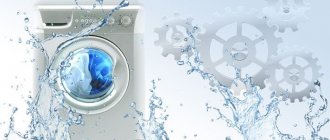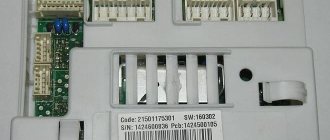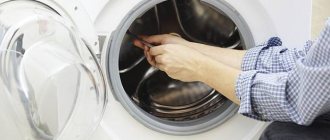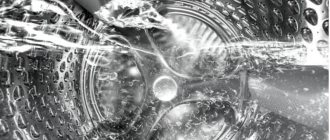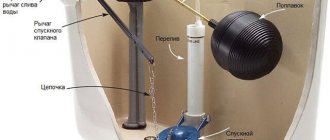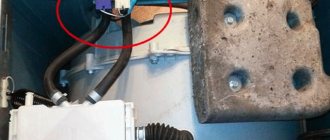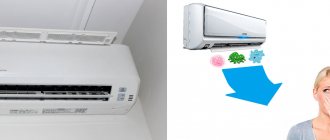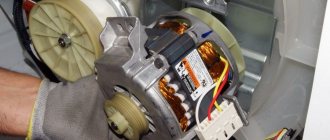Household reasons for lack of drainage
Sometimes the washing machine does not drain or spin due to household problems not related to a breakdown of the device.
Incorrect washing mode selected
If the washing mode with spin and drain was not selected in advance, the program simply will not start these processes on its own.
Sewer blockage
A clogged drain will prevent your washing machine from draining out of the tank. This is a fairly serious problem that only specialists with a set of necessary tools can help solve.
Spin cancel button pressed
Pressing the spin cancel button will naturally prevent this function from turning on after the wash is completed. So it is important to pay attention to this point in advance.
The spin speed regulator is set to 0
Almost all washing machines have the ability to adjust the spin speed using a handle. If this switch is set to 0, spinning simply stops.
Technical reasons for drain failure
Often, the washing machine does not spin clothes or drain water for a number of technical reasons, many of which can be eliminated on your own.
Drain filter clogged
The simplest option is to prevent water from passing through the system. Hair, threads, lint and various debris can accumulate and clog the filter. In this case, the solution will be to unscrew the element and wash it under running water.
Pump malfunction
Sometimes the water pump in the drain system can simply burn out due to voltage surges or too much load. A burnt out pump will require replacement.
Clogged pipe or hose
A clogged pipe may also prevent water from flowing into the drain. Moreover, sometimes this element is in an accessible place, and sometimes it is not possible to get to it without completely disassembling the washing machine.
The hose directly connecting the machine to the sewer becomes clogged somewhat less frequently due to its large diameter. However, this problem can also arise if the device is used for a long time without proper maintenance.
Control module malfunction
The control module is an electronic device that is fully responsible for enabling certain functions. Its malfunction may make it impossible to start the water drain program.
Water level sensor malfunction
The water level sensor detects the presence of water in the machine drum. It is this sensor that transmits a signal to the control module, which then turns on the drain. A broken sensor makes it impossible to determine the water level. Damaged sensors are usually replaced with new ones.
Damage to electrical wiring
All monitoring and control elements are connected to each other by wires, the integrity of which does not allow the signals to be transmitted correctly. Thus, the sensor is not able to signal the electronic controller about the need to drain.
Pressostat malfunction
A breakdown of the pressure switch is usually indicated by a corresponding error on the washing machine display. A faulty sensor in most cases implies a constant lack of water in the drum. Because of this, it cannot transmit a signal to start the drain procedure. The pressure switch may break due to a leak in the membrane, burning or oxidation of the contacts.
Engine malfunction
A malfunction of the motor makes the spinning process almost uncontrollable, which does not allow you to fully use the functionality of the device.
Damage to the tachometer or drive belt
The tachometer in the washing machine is responsible for regulating the engine speed. It also allows for high-quality spinning of clothes after washing. Its breakdown leads to uncontrolled rotation of the drum, leading to increased vibrations or a complete lack of rotation. And it is for this reason that the automatic machine does not drain the water and does not spin.
Emergency opening of the hatch door
If for some reason it was not possible to remove water from the system using the first two methods, you can try opening the SM hatch and scooping out the liquid manually. Before “breaking” the door, look at how much water is in the drum
Almost always, the liquid rises above the bottom edge of the hatch, so it is important to tilt the washer towards the wall. So, a “waterfall” will not flow from the tank when the door is opened sharply
The process of removing water is quite simple: you just need to open the machine and use a mug or ladle to scoop out the liquid. You may experience some difficulties when trying to unlock the machine.
You can open the washer using a thin rope. The cord is inserted into the gap between the door and the wall of the housing in the place where the locking lock is located. It is necessary to pull the ends of the rope so that it goes as deep as possible. Actions are performed until a characteristic click is heard. The hatch can then be opened.
If the machine breaks down, you will do anything to empty it of water and get things out of the drum. Therefore, if you cannot unscrew the garbage filter, and the drain hose is clogged and does not allow liquid to flow by gravity, you will have to use this method as the only possible one. The disadvantage of this method is that it requires more effort and time, since the scooping process is quite long.
What you can do yourself
Some manipulations to restore the functionality of the drainage system can be done independently. Some of them will not require virtually any investment, while others cannot be implemented without purchasing additional parts.
Drain the water
The first step is to drain the water from the inside of the machine. Even if the system is clogged, it will not be superfluous to additionally start the draining process. You may have to wait a while because the items may not function as usual.
Open the hatch and take out the laundry
Now you can open the hatch and remove the laundry without the risk of large amounts of water leaking out. A malfunction of the spin and drain system will cause the laundry to remain wet. It needs to be squeezed out and hung to dry.
Clean the drum
The next step is to clean the drum from dirt. They can prevent the normal drainage of water. For cleaning, you can use various sponges, hoes and detergents. However, you should not apply aggressive mixtures to the inside of the drum, as they can compromise the integrity of the material and lead to even greater problems.
Check the drain filter
One of the main elements of the washing machine drainage system is the filter. It protects pipelines from mechanical contaminants that can clog the lines and prevent the normal passage of liquid. The drain filter is often located at the front of the unit behind a special plug. It is necessary to remove the component and carefully inspect for the presence of large contaminants. It is necessary to inspect the central part of the filter especially carefully, since this is where rubber residues from the seals can accumulate. If necessary, the filter can be washed under running water.
Replace the pump
Replacing the pump seems to be a radical solution to the issue, which is taken only after achieving full confidence in its malfunction. The pump must be selected according to the appropriate parameters and preferably original. The use of third-party pumps can lead to inconsistencies in output indicators and unstable operation of the entire system.
In some car models, access to the pump is quite easy by unscrewing the back cover. But sometimes replacement can only be carried out after complete disassembly of the device, which is best left to a specialist.
Clear a clogged hose or pipe
A clogged hose or pipe can be eliminated by simply flushing all components of the drain system. There are no special skills or tools required. The most important thing is to put all the gaskets in place when reassembling. Otherwise, immediately after connecting the device to the water supply, significant leaks will be observed.
Repair features
Washing machines from different manufacturers have some specific features that appear during repairs. Taking these features into account will allow you to restore the equipment as quickly as possible and without any difficulties.
Indesit
Most Indesit washing machines for the Russian market are assembled in Russia. This is a budget equipment that can experience a variety of breakdowns from time to time. Most often, malfunctions are related to electronics, and in machines with front-loading laundry, the bearings wear out very quickly.
Zanussi
One of the most common problems for all Zanussi devices is drum jamming. This component is extremely sensitive to dirt and even the smallest mechanical inclusions. In addition, the design is clearly not designed to work with hard, salt-rich water. Filtration systems quickly fail, and heating elements often simply burn out during intensive use. Experts attribute frequent breakdowns of the heating element to the poor choice of material for the tubular part, which is typical for all product lines of the manufacturer. Repairs here are quite simple even without special skills.
Ardo
The weakest point of Ardo washing machines is considered to be electronics. Even with relatively gentle operation, key elements burn quite often. Moreover, repairs can be so expensive that it is more logical to just buy a new device. Fortunately, the cost of cars of this brand is low. It is worth noting that problems with electronics occur in all washing machines, but here they are most pronounced.
LG
Among all LG washing machines, the most popular are direct drive devices. In this case, the rotating drum is directly connected to the motor shaft without any belt drives. This allowed us to minimize wear of parts and significantly extend the service life of the unit.
Breakdown most often occurs in the drainage system, which has a specific design. Even with minimal contamination, the drain mechanism does not start, which leads to an error. Repair in this case comes down to complete cleaning of the entire drain system.
Also, owners of LG equipment may encounter a malfunction of the water intake sensor. Insufficient sealing of this unit leads to water ingress and subsequent freezing. Thus, the system cannot receive a signal to fill with water, which leads to the tank overflowing and the drain system turning on. As a result: constant self-draining with constant recruitment.
Samsung
Samsung branded machines boast reliability and durability. However, even here there is a possibility of failure of the heating elements. But this problem can almost always be solved by replacing the heating element yourself at home.
During operation, machines vibrate a lot, which can lead to loose connections and wear of some components. It is especially common to find a torn belt, which can be replaced at home. However, it is recommended to use only products for your car model.
The inconvenient location of the filter does not allow it to be cleaned frequently, which can lead to contamination of the drain system. The way out of this situation seems to be to dismantle the structure and thoroughly wash away all contaminants. You should also not neglect timely replacement of the filter, even if this procedure is difficult to carry out.
Eyelid
Most of the breakdowns in Veko washing machines are associated with contamination of the drain paths or problems with the electronic module. In the first case, it is enough to simply carry out a thorough cleaning. The second type of malfunction may require repair or complete replacement of the control unit. Replacement is most preferable if there is no desire to understand the intricacies of electronics or seek help from a specialist.
Sometimes there is also a breakdown of temperature sensors, resulting in the impossibility of heating water. This is where a repair specialist can best help.
Ariston
Ariston company produces reliable washing machines. Malfunctions most often arise due to specific operating modes. Too hard water, insufficient care and infrequent filter changes can lead to failure of the device.
Sometimes during operation they may begin to hum and vibrate. This problem is best identified and corrected at the very beginning. Otherwise, there is a high risk of aggravation, with further wear of key elements.
It is worth noting that most of the elements are represented by non-demountable structures, the breakdown of which cannot be eliminated without the help of specialists.
Wise use of the washing machine's capabilities will allow you to enjoy its performance for a long time. However, from time to time some problems may still arise, the presence of which will prevent you from washing things comfortably. Lack of drainage seems to be a fairly common problem, which can very often be solved independently at home.
“Suddenly”: the washing machine does not drain water - What to do?
There comes a time when, having opened the washing machine, instead of slightly damp laundry, you find it floating in water. Well, if it’s clean, then the reason why the washing machine doesn’t drain the water or spin out the laundry instantly becomes clear: they “messed up” themselves. This happens when you accidentally programmed the unit for the “delicate wash” mode. The worst case scenario is that dirty water remains inside the drum. Roll up your sleeves, turn on your brain and think about how to figure out the breakdown yourself.
We try to figure it out ourselves or “What should we do?”
An emergency situation with household appliances sows panic and a desire to immediately call a technician, repairman, or plumber. Calmly! We disconnect the unit from the network. We are looking for the cause - you yourself can diagnose and “cure” the machine. Start self-diagnosis by examining the water supply system - sewer drain:
The washing machine does not drain water through the hose if it is kinked. We can easily fix the problem.
If the corrugation is in order, and the drain in the washing machine does not turn on, we move on to the filter: in a top-loading machine, small things sometimes “fly” past the drum and clog the filter. We take out the “unpleasant little things” from it.
The machine does not completely drain the water, which has an unpleasant odor - the problem is a clogged drain or sewer. Clean it with available means (clog removers or a special cable) or call a plumber. In the future, install an anti-siphon (non-return) valve on the drain - it will block the access of sewage to the washing machine.
Check your program selection. Remember: the “delicate wash” mode does not drain the water.
If the liner, filter, and drainage are normal, your independent actions are completed, it’s time to turn to the experts. Remove the laundry from the machine, manually spin it, and drain the water through the filter. It is located at the bottom of the household appliance under the plastic panel. Unscrew the cap counterclockwise. If it doesn’t work, don’t be zealous, you can break the “snail” and then you’ll have to completely change the filter.
You can also drain the water from the drum by disconnecting the drain hose from the siphon.
Go to “wet work” fully prepared: when draining water by hand, stock up on basins, buckets, rags, otherwise you will cause a flood for yourself and your neighbors. Up to 20 liters of liquid may remain in the unit. Don't forget to turn off the power to the washing machine!
Frequent reasons for contacting service
* The technician will be able to tell you the exact cost after inspecting the washing machine.
** Prices shown are for specialist work, excluding spare parts
The module for controlling these processes malfunctioned. Replacement is carried out at the customer's home. With an accurate diagnosis, the technician can repair the board without buying a new one, thereby saving you money.
50% of the cost of new
The automation gives a signal: “Washing is finished.” The problem is created by the water sensor, in professional terms, a pressure switch. It provides incorrect information to the control unit. Replacing the sensor will solve the problem, but using “low-volume” detergents will not create it. Remember, “too much” with washing powder leads to “sticking” of the contacts of the water sensor.
When calling for service, the consumer characterizes the malfunction this way: “it cracks (buzzes, makes noise) and does not drain (drains for a long time) the water.” The noise comes from the pump if coins, hooks got into the impeller (wheel) and its blades broke off. Even if the pump’s electric motor is in good working order, and the impeller has received mechanical damage, the technician will completely change the assembly.
It is located inside the dirty water removal machine and is connected to a pump. A clogged pipe causes the drain to not start.
Clean your machine's drain filter periodically, and don't forget to check your clothing pockets before washing. Before the technician arrives, turn off the household appliances, drain the water, and remove the laundry from the drum.
BystroService Facts
- More than 3,500 washing machines were saved during 4 years of operation
- Original spare parts. We give the receipt and packaging along with the part.
- Inexpensive repairs from 600 rubles.
- We only deal with washing machines. We know everything about them!
- Only Russian masters with at least 4 years of experience.
- Warranty up to 2 years, we issue the official form BSO-1
Call a technician and diagnose your machine - free of charge!
If your washing machine is broken and you don’t know what’s wrong with it, leave your number. We will call you back within 5 minutes and agree on a convenient diagnostic time.
